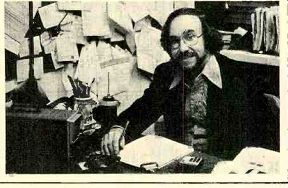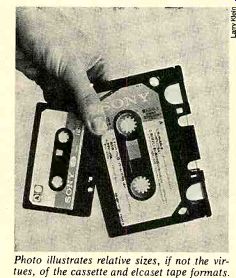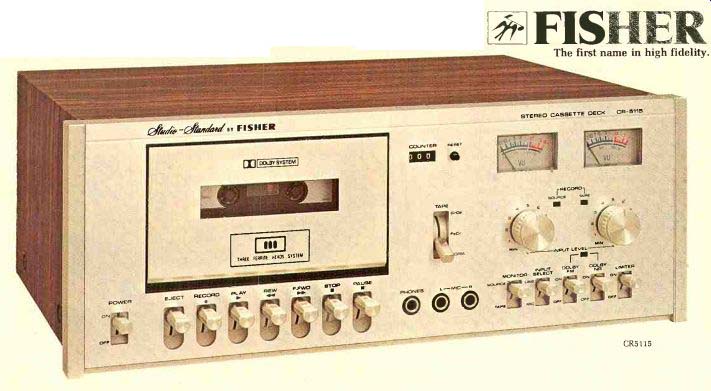
Which Tape Format?
Q. I'm considering adding a tape machine to my system, but I can't make up my mind whether to go cartridge, cassette, elcaset, or open-reel. What are the relative advantages of each format both for recording and for playing back pre-recorded tapes?
ARTHUR KRAMER Philadelphia, Pa.
A. Choose open-reel if you are interested in making live tapes, editing, and monitoring while recording. The open-reel format also provides (by at least a small margin) the lowest distortion, widest frequency response, lowest wow and flutter, and lowest noise levels, and it is less likely to distort high-frequency signal peaks. Cassettes, on the other hand, have the virtues of compactness, convenience, and a performance level (in the top quality machines) that will satisfy all but the most critical listeners. Off-the-tape monitoring is available with cassettes, but only in the expensive three-head decks.
Eight-track cartridges have many of the same deficiencies as the cassette when com pared with open-reel machines, plus specific problems of their own. In addition, they are far less convenient to record on than cassettes because of their use of four sets of parallel stereo tracks on a continuous-loop tape. Pre recorded eight-track cartridges played at home-rather than in a car-have a hiss level that makes them unacceptable for critical listeners (road noise masks the hiss in cars). Al though the usual run of prerecorded cassettes are only marginally better in this regard, the Advent prerecorded cassettes all sound fine.
(For a free copy of the Advent catalog, write to: S. R. Shapiro, Advent Corp., 195 Albany Street, Cambridge, Mass. 02139.) The year-old elcaset format is off to a slow start, and it's hard to judge at the moment where it will be going. Although I have few if any reservations about its potential technical quality or convenience, the relatively high consumer cost of the elcaset machines and tape cartridges may inhibit sales to the point that the format will have difficulty achieving wide acceptance. I know of no plans at the moment for a prerecorded elcaset catalog.
The elcaset format and the thinking behind it were discussed in the October 1976 issue of STEREO REVIEW.

--- Photo illustrates relative sizes, if not the virtues, of the cassette
and elcaset tape formats.
Open-reel prerecorded tapes have slowly improved over the years, but, when they are compared to the best discs, I find that their superiority is neither sufficient nor consistent enough to justify their extra cost. And prerecorded tapes in any format do not provide the easy location of selections that discs do, al though some sophisticated new elcaset and cassette machines have selection-finder circuits built in. (Note that my comments on sonic quality are directed only at the commercial prerecorded products. The home tape recordist can easily turn out tapes in any format that are hard to tell from the original program, assuming that the machine and the tape used are of good quality.) Since I'm aware that my views on the question of duplicated tape quality can be argued with, in the interest of fair play and equal time I refer you to Barclay-Crocker: B-C, if not the largest, is at least one of the foremost retail specialists in open-reel prerecorded tapes, carrying an extremely wide selection of titles including some they are duplicating them selves. Although the prerecorded tape market is somewhat confused at the moment, with various labels either being discontinued or looking for a home, B-C is the first place to look for whatever is available. They offer a fast, efficient personalized service both over the counter and through mail order, and visitors are welcome to stop in and browse. A catalog costs $1. The address is Barclay Crocker, Dept. SR, 11 Broadway, New York, N.Y. 10004.
Missing Highs
Q. The prerecorded cassettes I have been buying lately, which are marked in very small print as being Dolby B processed, have highs in playback only when the Dolby circuit is switched off; when I switch in my deck's Dolby circuit the highs disappear. I think I would rather have the highs and the hiss than neither.
PAT BREWSTER; Seattle, Wash.
A. Many of the cassette duplicators in the United States, for one reason or another (mostly because of inadequate care and equipment), don't record the audio frequencies above 8,000 Hz or so at full strength on their prerecorded cassettes. Since the Dolby encoding process boosts the low-level high frequencies, Dolbyized tapes played without decoding sound somewhat brighter than non Dolbyized tapes. However, when you switch in the Dolby decoding, the extra boost is re moved-as it should be-along with 5 or 6 dB of hiss, and you are left with a tape that is reasonably hiss-free but sounds dull because of the highs that were lost in the duplication process. It is obvious that the problem lies not with Dolby processing, but rather with those duplicators who are doing such a rotten job. This is not true of all prerecorded cassettes; the Advent releases, for example, demonstrate just how good Dolbyized prerecorded cassettes can be.
Incidentally, if you seem to be losing highs with your own home-made Dolby cassettes, first check the performance of your machine by dubbing and playing back a disc without the Dolby circuits switched in. If everything sounds okay without Dolby, but high-frequency loss is heard when you record and play through the Dolby circuits, then either your tape machine's equalization and bias do not match the requirements of the tape you are using (a small loss in highs because of overbias, for example, will be doubled by the Dolby circuits), or the Dolby circuits in your machine are not properly adjusted.
Old Tape, New Deck
Q. I've been considering upgrading my cassette deck to a front-loading type. However, I've been told that tapes recorded on one good deck will not always sound first-rate on a different good deck. Will a new, higher-quality deck play my previously recorded tapes with out any loss in sound quality?
BILL BROCK; Keswick, Va.
A. First of all, I detect an implication in your question that front-loading decks are necessarily of higher quality than top-loading types. Some are-but some aren't.
Front loading is a convenience factor; in and of itself it has nothing to do with machine quality, and it seems likely to me that a $400 top loader is going to deliver better performance overall than a $200 front loader.
As I understand your question, you are asking whether a tape that plays back with good quality on the deck on which it was made can sound less good on a different deck with bet ter specs. Assuming that the original cassette deck was correctly adjusted for the standard playback curves, and its head(s) were accurately aligned, then in general it is safe to assume that tapes made on it are going to play back as well or better on other correctly adjusted quality decks.
There are, however, a couple of areas where frequency-response discrepancies may occur. Over the years there has been a shift in the standard low-frequency equalization characteristic of cassettes, with the result that tapes played on machines made at different times may sound slightly bass-heavy or bass-shy. Also, some manufacturers' machines are not accurately aligned to the Dolby record-playback characteristic. This may cause a slight but audible boost or cut in the low-level high frequencies when playing back tapes on machines other than the one they were re corded on. In general, however, the improved overall characteristics of the newer or more expensive machines will usually provide somewhat improved sound-even from older recorded tapes.
Dubbing Dolby
Q. My question is rather simple: when recording a Dolbyized tape from one deck to another, is it better to decode the tape playing from deck No. 1 and re-encode when re cording on deck No. 2, or to record the tape from deck No. 1 to deck No. 2 without decoding and re-encoding?
A. RINGEL; Brooklyn, N.Y.
A. Best results are achieved in duplicating. Dolbyized tapes (when they lack a reference test tone) if you decode the signal and then re-encode it when making the copy. Although this may seem like redundant processing, it is necessary because proper decoding of a Dolbyized signal can be achieved only if the decoder circuits "track" the encoding both in signal level and frequency. When you copy Dolbyized audio material (without de coding it, that is), the odds are that it will be recorded on the new tape at a higher or lower level than on the original tape. This can con fuse the Dolby decoding circuits because the Dolby reference level has been shifted. However, if there is a Dolby-level test tone on the tape with the encoded program, then this can serve as a zero-reference guide during future duplications--and without decoding. Note that any frequency aberration that occurs in the signal after it has been encoded (because of the use of a "hotter" tape for the copy, for example) will be emphasized by the decoding process. In short, if an encoded signal is not fed to the decoder circuits at exactly the same reference level at all frequencies that it had when encoded, then the Dolby circuits simply cannot react properly. The result is a diminution of the noise-reduction potential of the Dolby circuits and some high-frequency boost (or loss) in playback of low-level (soft) audio signals.

Also see:
AUDIO BASICS--On Buying a Tape Recorder, RALPH HODGES
TAPE RECORDING--A professional shares his tips on how to do it right, JOHN WORAM